By Jane Morrell and Sarah Whelan
Standing in the window space of Avedian Coast on Lexington Avenue, local model Camille Reid smiles and poses in an asymmetrical cotton dress with sides of deep purple and flashy red bordering a chaotic rainbow pattern like television static.
The boutique’s showroom is filled with jazzy reds, ashy blues and dazzling greens — a spectrum of garments, many of which were created from a puzzle of textile waste.
The fashion on display here is made through a process called upcycling. In a way, upcycling is like the recycling we do with our cans and bottles: It also uses that concept of reusing and reducing waste material — but it’s not exactly cut from the same cloth.
“[Upcycling] is very specific,” explains Stina Anderson, owner and designer of ARTeries, an upcycled clothing and accessories line. “Recycling, that’s redoing. Upcycling is actually taking something [and] improving upon it. Primarily, it’s built around the philosophy of making something new again.”
Anderson says her work is a “fusion” that combines post-consumer clothing with new and used materials to create custom pieces. The result, she says, is garments that are handcrafted, unique and visually distinct from most off-the-rack options. After all, as Anderson asserts in her company’s tagline, “every woman wants a dress that no one else has.”
Reduce, reuse, upcycle
According to the Council for Textile Recycling, the United States generates an average of 25 billion pounds of textiles annually — from clothing and footwear to accessories, bedding and drapery. Of that 25 billion, an estimated 21 billion — 85 percent — will end up in landfills each year. In fact, textiles account for 5.2 percent of the country’s municipal solid waste, and that amount is growing. The council estimates that in 1999 the U.S. generated 18.2 billion pounds of post-consumer textile waste, but by 2019 that number is projected to increase to 35.4 billion.
Furthermore, the Institute for Sustainable Communication reports the textile industry is one of the world’s largest polluters, contributing to contamination of drinking water through chemical runoff or from dyes seeping out of clothing in landfills. The Journal of Hazardous Materials reports that chemicals used in dyes — including formaldehyde, a known respiratory irritant, as well as fluoride, phthalates and nonylphenols — have been detected in treated drinking water.
“[By upcycling] you’re saving the environment from a lot of chemical processes that a lot of times involve caustic chemicals that are bad for the environment,” notes John Riddle, textile expert of the Hickory-based clothing line Recover Brands. At Recover, Riddle sources fabrics from traditional sources such as excess industrial cotton, as well as some surprising ones — primarily, extracting polyester from discarded plastic bottles. The salvaged materials are used to create Recover’s 100 percent recycled apparel line — another spin on upcycling.
Riddle estimates that the company sources a quarter million pounds of cotton annually from manufacturers such as Nike and Haynes. Additionally, Recover salvages around 2.5 million plastic bottles each year.
Larger upcycled lines, such as Recover, are able to utilize connections with national manufacturers. Smaller-scale designers like Anderson will use leftover fabrics, thrift-store pieces or even donations of vintage garments to turn anything from a T-shirt or a suede jacket into a new suit, a handbag or even a pair of toreador pants.
Stitch by stitch
Upcycling is also a chance to wear an actual art piece, notes Gigi Renee, designer and owner of Vintage Moon. “[An upcycled piece] is different,” she explains. “You know you’re not going to find it in Urban Outfitters or the mall.”
To create an upcycled piece, Renee begins with her collection of vintage fabrics and antique textiles — silks, velvets, lace and embroidery — that she’ll combine into a wearable collage. If she has a stiff piece of crochet or lace, she’ll soak it in warm water to loosen the threads before stitching it into the new garment. She hand-dyes her work, utilizing methods such as Shibori, indigo and acid dying to make each piece one-of-a-kind. But her favorite process is eco-print dying — where she applies botanicals and metals to the fabric to introduce patterns and colors.
Renee says that recycling is the foundation for her work. “To be able to turn an old item into something to be presently cherished and enjoyed gives me a deep sense of creative satisfaction,” she explains.
The pieces that designers like Renee produce can vary from professional suit jackets to casual sundresses and crop tops — but the techniques to create the pieces require dedication and labor, often taking entire days or weeks to create.
Asheville’s fashion district
It’s not difficult to find upcycled pieces in Asheville. In fact, the style is prominently displayed in several stores on Lexington Avenue, which Renee compares to the artsy Haight-Ashbury district in San Francisco.
“The boutiques down here are very unique,” she says. “They’re not like your wholesale buyers that are just buying stuff that you can get anywhere.”
According to Franzi Charen, owner of Hip Replacements and director of the Asheville Grown Business Alliance, Lexington Avenue has long been home to sustainable fashion. Charen notes that upcycled and vintage pieces can be found at Honeypot, Vintage Moon, Royal Peasantry, Aveidan Coast and Hip Replacements — all located within a short walk of each other. In fact, independent boutiques and clothing artists seem to flock to this part of downtown.
“I think the draw for the alternative culture and the love for Lexington Avenue has always been known to be welcoming to everybody,” Charen notes.
However, Lexington was not always regarded as the place to be for Asheville fashion.”I know that there was a time where even the Chamber [of Commerce] warned against going down Lexington,” Charen notes. “This street, back as early as the ’90s and early 2000s, was culturally very interesting, [but] it was home to a lot of people who lived on the streets.”
However ironic, just like upcycled clothing, Lexington has transformed from rags to riches, while still hanging onto its independent vibe. Sarah Legatski, owner of Honey Pot, says many shoppers come to Lexington’s boutiques looking for “a sense of self and nonhomogenization.”
Legatski says that while her store focuses solely on vintage wears, she believes both upcycled and recycled clothing fit the Asheville personality. “It’s original,” she explains. “The thing both [styles] have in common is that each piece stands on its own, and people really like that. It feeds the diversity and the independence that this town prides itself on.”
The unique look of repurposed clothing also attracts a wide variety of consumers, from locals to tourists. In fact, Legatski, Charen and Anderson all noted that tourism has been a driving force behind the upcycled clothing scene in Asheville over the years. Anderson notes that her dresses can range in price from $65 to $350 depending on the amount of labor that went into each piece, but that many out-of-town shoppers are more than willing to pay the price for the one-of-a-kind look.
It’s not uncommon to find a Lexington Avenue customer willing to invest in handmade fashion and local artists, adds Legatski, and attracting that kind of consumer can be a great asset to the local economy. “I think that is a growing point for Asheville,” she says. “The money is here, and it’s walking down our streets. I mean, we’ve all caught the tweet that this actor is here now, and this person is there and Kristen Wiig’s been here — we’ve seen so many people come through here.”
Bursting at the seams
Anderson notes that even though several boutiques are crowded onto Lexington Avenue, so far the vibe has been more community than competition. “There are some really strong designers here in Asheville, and it’s been cool to watch it grow over time,” she notes. “Everyone succeeded in their own paths.”
However, that sense of welcome might not extend to some of the newer kids on the block. Larger clothing corporations have jumped onto the upcycled and vintage style, offering lower-priced garments that might mimic the look of repurposed fashion, but not the manufacturing practices. Recent news of an Anthropolgie store opening on Lexington Avenue — following in the footsteps of Urban Outfitters on Haywood Street — sparked concern among many shopkeepers, including Dean Peterson with Tops for Shoes, who noted that the entrance of multiple chains stores can lead to increased rents in downtown, driving out small businesses with tighter budgets.
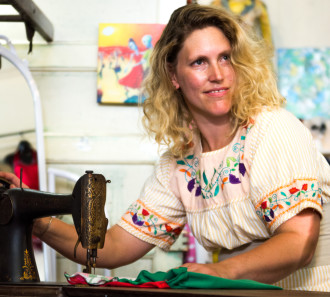
Charen agrees, adding that “downtown Asheville is facing the reality of being overtaken by outside landlords and retail chains. As local businesses get priced out of the market, we lose much of our unique culture.”
She adds that a conversation about downtown’s future should consider both the present situation and what the next few decades could bring. “We all want a downtown that we can live, work and play in, and we must prioritize the needs of residents in our community over those that only wish to extract resources,” she notes. “We must look 20 years down the road at the real implications of these decisions based on short-term profit and outside interests.”
The concern over the potentially changing face of Lexington Avenue and other streets in downtown led Adorn Salon owner Rebecca Hecht, who is also a member of the Asheville Downtown Commission, to create an online petition calling for local leaders to “regulate and/or place a moratorium on chain and formula stores in downtown.” The petition garnered more than 2,000 signatures in less than a week.
“From the commissioners’ perspective, I think we all feel that it’s time to start the conversation about how we guide the development of downtown,” Hecht says.
However, not all Lexington boutique owners are opposed to Anthropologie and other chain stores coming into downtown. Anderson says that Asheville needs to maintain a “fine balance” between local and national stores, but adds that the presence of larger corporations may actually bring more consumers to her business by drawing the attention of tourists and leading them to explore Asheville’s other fashion options.
“When you have bigger stores move into an area like this, you have to look at the bigger picture,” Anderson says. “Maybe those tourists don’t know that Lexington Avenue is so awesome. Maybe they need to stumble upon us, but they wouldn’t have done that if hadn’t known Urban Outfitters.”
Renee notes that ultimately the situation will rely on customers who may choose to shop in big-box stores also continuing to support independent boutiques. “We, as independent artists and business owners, want to keep the local economy thriving,” she notes. “The only way we can survive is to depend on the consumer to come in and shop in our stores.”
One of a kind
Anderson adds that ultimately what will keep bringing customers to her store is the desire for a something unique. Upcyling allows her to utilize repurposed materials to keep prices lower on her custom pieces, but it also allows her customers to show off their environmental consciousness, she says.
“I feel like when people wear upcycle, they wear a brand that is very visually made from materials that were something else,” she notes. Effectively, upcycling is wearing your green on your sleeve.
Anderson notes that customers who purchase upcycled clothing are more likely to be aware of and promote the need to reduce textile waste. “[A lot of consumers] want more, and they want new, and when you have really accessible, cheap clothing that is produced with no accountability for waste, there really is no end in sight,” she says.
But upcycled and vintage wares may help promote the exchange that there could be a better way, she adds. “We all have to help each other and educate each other about how to upcycle and recycle,” she says. “There is nothing more valuable than that kind of exchange. That’s what is trendy now — people want to be green.”
Jane Morrell is a student from Troy University in Alabama and an intern with Mountain Xpress. Follow her on Twitter @JaneMorrell2
Sarah Whelan is a student from Randolph Community College, a freelance photojournalist and an intern with Mountain Xpress. Follow her on Twitter @WhelanSarah_


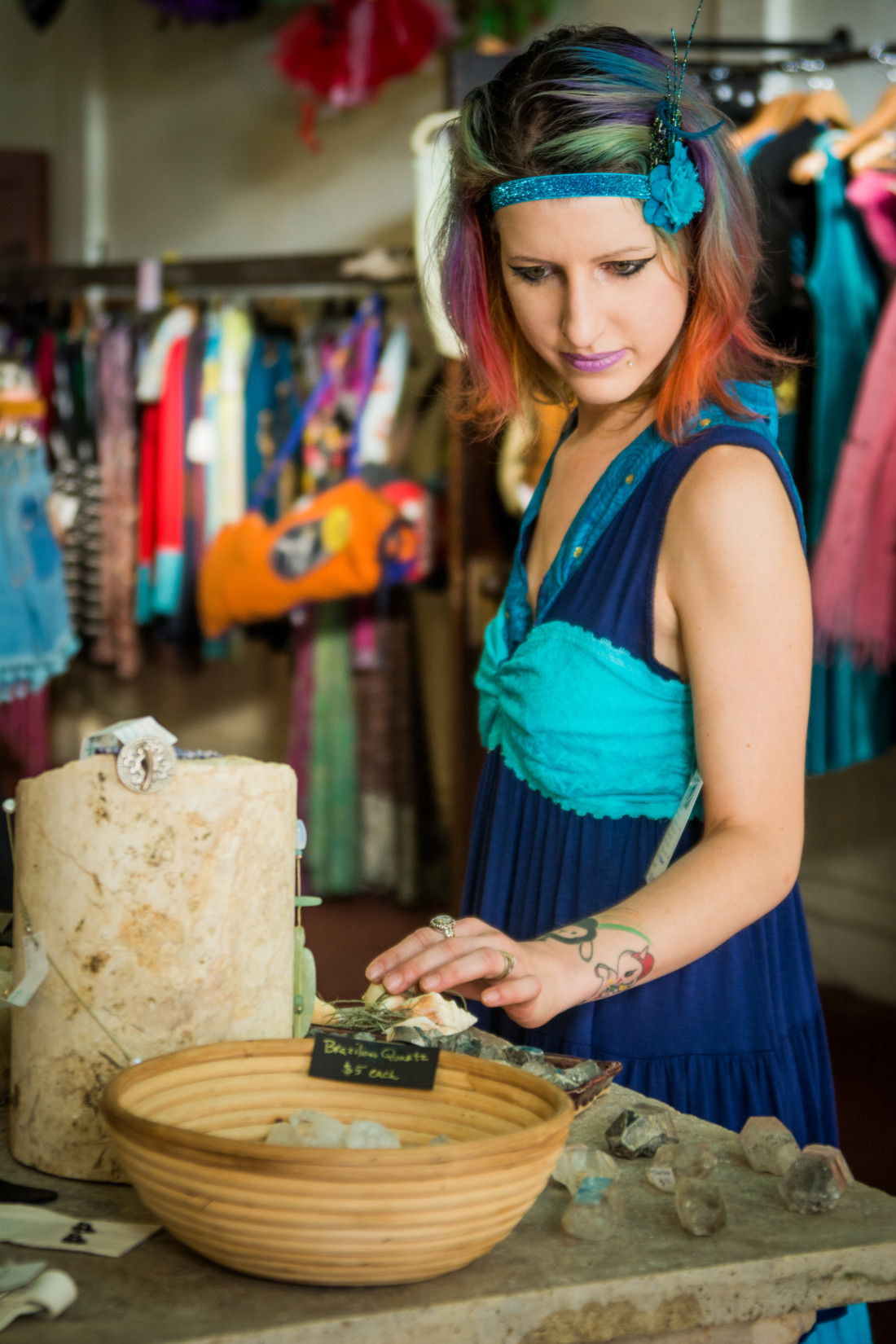
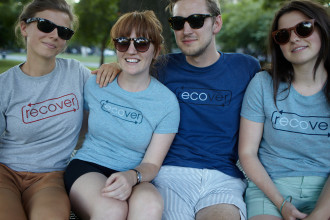
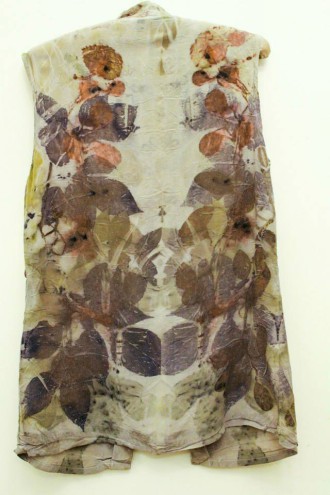

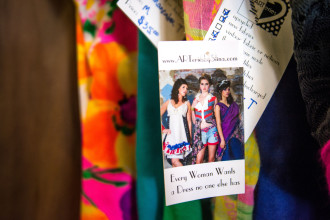
You should definitely check out Hippy Chic Hawaii as well (www.hippychichawaii.com). They take used fired house and create very fashionable belts, wallets, keychains, dog collars, dog leashes, and other things. They’ve diverted nearly 10 tons of used fire hoses out of Hawaii’s very limited landfill space! Thank you for sharing this!